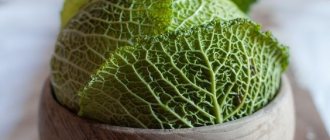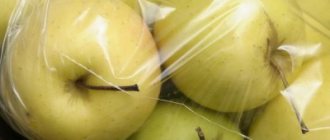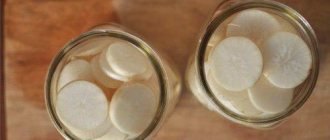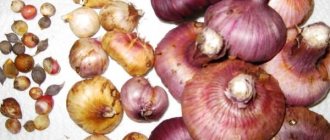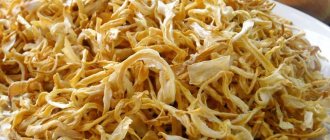Which daikon can be stored for a long time?
Daikon is a type of radish, so the growing and storing conditions for both vegetables are similar. Daikon is often called Japanese radish. The vegetable is truly loved in Asia: slices or sticks of daikon are added to various dishes of Japanese and Pan-Asian cuisine. If you take into account all the features, you can preserve the root crop for a long time.
When you want to cook a dish with daikon in winter, you just need to take the vegetables out of storage or defrost the preparation, and then prepare a salad, soup or side dish. Daikon should be stored taking into account the varietal varieties.
Varieties are classified according to several principles:
- by type of occurrence in the soil;
- taking into account shape and size;
- according to soil requirements.
It is best to store mid-season varieties.
Typically, early daikon matures in 40 days, while late daikon becomes technically mature in 70 days. It is customary to use early root vegetables for preparing seasonal dishes, and use late ones for preparing preparations.
You can make canned vegetables from radishes. Pickled daikon is considered an excellent dish in Asia; many Asians taste it like the popular pickled ginger. It is known that there are 2 types of daikon: summer and winter.
Both types have significant differences:
- Summer root vegetables do not last long. The maximum storage period is 2 weeks. Summer varieties are usually early ripening and are used for preparing seasonal dishes.
- Winter varieties are mid- and late-ripening varieties. Such root crops often last until spring without loss of quality if they are stored correctly.
Popular varieties that are suitable for long-term storage:
- "Dubinushka." This is a daikon of small length, the weight of one root crop reaches 1.5 kg. The taste of radish is sweetish, but not tart. Root vegetables are great for long-term storage.
- "Big Bull" Root crops of this variety grow up to 3 kg. The fruits tolerate temperature changes well and are suitable for long-term storage. The only drawback is that the fruits are too large, which creates some inconvenience during storage. It is not always possible to use a 3-kilogram daikon for cooking, and storing the trimmings is quite difficult.
- "The Dragon". A cylindrical root crop up to 1.5 m long. The weight can be from 1.2 to 2.5 kg. It is distinguished by a sweetish taste. The variety is recommended for combination with other vegetables. It is most often used to prepare salads and vegetable side dishes.
- "Emperor". An excellent variety in the form of an icicle, which has a sweetish taste and aroma. The main feature is resistance to various diseases. It stores well and is not susceptible to mold.
How to determine if daikon is ready for harvesting
Harvesting time occurs 40-70 days from the moment the first shoots peck. It depends on the variety, as they are divided into early and late ripening.
Summer radish harvest time
Early varieties are sown in early spring and harvested in June
It is important to focus on the weather conditions of the region and the characteristics of the variety. Delay in harvesting longer than 40-50 days for summer varieties threatens the formation of shoots
The exception is hybrid varieties that are resistant to bolting. A mature root vegetable, ready to eat, has the following characteristics:
- dense, juicy green tops;
- elastic root of a white, pinkish or purple hue (depending on the variety);
- the shape of the fruit is smooth, long cone-shaped or spherical;
- the pulp is juicy, white, pleasant taste without strong bitterness;
- The size of the root crop reaches from 20 cm to 2.5 m, depending on the variety.
Winter daikon harvest time
Root crops for winter storage are sown at the end of July or beginning of August in central Russia and in the Moscow region. The growing season reaches 60-70 days. The vegetable must be harvested at the end of September - mid-October. In any region, the harvest must be harvested before the first frost. In warm, sunny daytime weather and cool nights, you need to cover the beds at night with non-woven material or a special covering fabric. Delay in harvesting to sub-zero temperatures risks freezing of the part of the root crop protruding from the ground.
The main guideline for harvesting daikon is the air temperature in a particular region. Therefore, harvesting times in the south of the country, in the middle zone and Siberia are different. Sometimes the fruits do not have time to ripen before the onset of frost and the root crop looks like a white carrot. But the taste and quality characteristics of the fruit do not suffer from this. Unripe daikon is also ready for fresh consumption and for cooking.
An adult, mature plant grown for winter storage has the same set of characteristics as a summer vegetable.
When to remove daikon from the garden in the fall
Storing daikon at home is not a difficult task. Preparations for this process begin long before laying for the winter. Preparation is important, that is, harvesting, which traditionally occurs in August-September.
The exact timing depends on the varietal variety:
- early ripening varieties are harvested at the very beginning of the month;
- mid-season by the middle of the month;
- Late-ripening ones are harvested in late August or early autumn.
When harvesting, you should follow the sequence of steps:
- First, the daikon is removed from the ground and allowed to dry in the garden for several hours.
- After this, the tops are cut, leaving petioles 2.5 cm long, and put under a canopy.
- During drying under a canopy, the vegetables are sorted again and those unsuitable for storage are rejected, based on color and density.
After the daikon is dried and processed, preparations for storing it for the winter begin. When planning harvesting, it is better to choose a day when the weather is warm and dry. The soil between the rows of vegetables is loosened so that each radish can be pulled out of the ground without difficulty.
Proper storage of daikon in winter
The shelf life of the product depends on the quality of the assembly. Those root vegetables that have already been dug up need to be left in the garden for five hours so that the skin dries out a little. If the day is very sunny and warm, then the fruits should be brought to a place that is not so bright.
Next, the soil needs to be shaken a little and removed, but the tool should not be sharp. An ordinary rag is perfect for this task. The tops need to be trimmed, leaving the top about two and a half centimeters. For high-quality storage, root vegetables must be as follows:
- not flaccid and elastic, so that density is felt;
- the skin should have a greenish-cream or white color, and also a pink tint in certain varieties.
Winter storage rules
The harvested crop is recommended to be stored under certain conditions. An important part of the preparation is drying the vegetable. If it is wet, then the ability to retain beneficial properties and structure density will be significantly reduced.
There are several ways and places for storage:
- basement or cellar;
- inside the apartment (on the balcony or pantry shelf)
- in the form of canned food or pickled preparation;
- freezing
How to store in the cellar
Cellar or basement storage is the best option. It is perfect for those who own a private house, cottage or garage with a basement. There the optimum air temperature and a fairly comfortable level of humidity are maintained.
Here's how to pack daikon in sandboxes for winter storage.
To ensure that root vegetables retain their beneficial properties and remain juicy for a long time, it is better to store daikon in boxes with sand or sawdust. These materials absorb excess moisture, but at the same time maintain an optimal humidity level.
You can store daikon in the basement using spacious wooden boxes. But you need to cover the top of the container with non-woven material, leaving small gaps. In addition, sorting through vegetables with the obligatory removal of rotten, limp or pest-damaged root crops becomes an important condition.
Neighborhood with other vegetables and storage in the apartment
Daikon (white radish): beneficial properties and contraindications
Radish can be stored together with other vegetables. It gets along especially well with potatoes and carrots. Experienced summer residents advise putting vegetables in bulk in bins 1 m high. You can also sprinkle them with sand and put them in boxes, stacking them on top of each other. Such methods allow you to store a large volume of vegetables in a small room.
Those who do not have a cellar do not necessarily have to give up growing and storing root vegetables. Radish is stored well all winter in large film bags. They can be placed on a dry and sealed balcony in a city apartment, where the temperature does not drop below 0°C.
Regardless of which storage method you choose, be sure to inspect your crops regularly. Remove any diseased or rotten roots immediately. Also remove all vegetables that are located next to them or sprinkle them with chalk. This will stop the spread of the disease
It is very important to constantly monitor the temperature and humidity in the room, preventing them from changing greatly
Thus, arranging proper storage of radishes is not so difficult. The main thing is to correctly determine its variety and fully carry out all the necessary preparations. Remember that only winter varieties of radish and daikon are suitable for long-term storage. The preservation of their beneficial properties directly depends on how you store vegetables.
PodvalDoma.ru
- Useful properties of daikon
- Benefits of daikon
- About the benefits of daikon
- Growing daikon in open ground
- Planting daikon in spring
- Taste of daikon
- The best varieties of daikon
- What to cook from daikon
- Care and planting of daikon
- Growing daikon
- How to store daikon
- Growing daikon from seeds
- Everything about growing daikon
- What is the best way to store cabbage in the cellar?
- Daikon pests
- What variety of carrots are best stored?
How to preserve at home
Storage conditions may vary: on a pantry shelf, inside a niche for canned goods on the north side. The only condition is compliance with optimal indicators.
In the apartment
You can store vegetables on a pantry shelf only if the conditions are as close to ideal as possible.
Table of optimal indicators for storing daikon:
| Air temperature | 0-5 degrees |
| Humidity | 75 % |
| Permissible fluctuations | 5 degrees |
In a refrigerator
You should store regular daikon on the refrigerator shelf without first washing the vegetable. It is enough to get rid of the layer of dirt and dry the surface. The radish should be packaged in plastic bags, holes must be made inside to allow air to enter, and then placed on the bottom shelf or in the vegetable compartment.
Once every 2 weeks you should sort through the vegetables and wipe the surface with a soft cloth or napkin if condensation forms on the surface. In this way, you can preserve daikon for 4 months.
On the balcony
If the apartment owners have a glazed and insulated loggia, then sand boxes can be placed here. With their help, you can preserve vegetables in the same way as in a basement or cellar.
How to prepare white radish?
- If the root crop is grown on a personal plot, it is important to harvest the crop on time. You need to dig up vegetables for long-term storage in mid-September, in dry weather. The root crop should dry in a dry, ventilated place. 2-3 days outdoors in sunny, cool weather is enough.
- After drying, the vegetables need to be sorted, leaving only strong, smooth fruits. Vegetables that are damaged, irregular in shape, or discolored are set aside for use as food immediately after harvest.
- The next stage is cleaning the surface from dirt. Radishes should not be washed with water. The fruit is cleaned with a soft cloth from excess soil or a special brush with soft bristles. Do not damage the skin.
How to properly keep the harvest fresh for the winter at home in a city apartment or in a private house; can radishes be frozen?
The root vegetable can be stored fresh or frozen. Possible storage options:
- cellar;
- at home in sand or bags (refrigerator, balcony, closet);
- barn;
- in processed form: juices, salads;
- frozen.
In the absence of a cellar or vegetable pit, daikon is well preserved on a closed balcony with above-zero temperatures or in the refrigerator on the bottom shelf. At home, the vegetable can be stored for 2 to 6 months.
Is it possible to freeze
Experts say that the benefits of vegetables that are consumed after freezing are at a high level, so using the freezer for storage is a justified option.
To freeze the vegetable, wash it, peel it, cut it into strips or grate it. Pieces of daikon are distributed into portions and frozen. The beneficial properties last for six months.
Tips and tricks
Another way is to prepare natural juice from a healthy vegetable. This technique is actively used if some vegetables are damaged during harvesting. The juice extracted using a juicer is poured into sterile jars, closed, pasteurized, hermetically sealed, and then stored in a cool place.
Another alternative storage option is drying vegetables. The root crop is prepared for this, passed through a slicer, then dried in any way: in the oven, dryer, on any surface. The resulting chips are stored in glass jars with a tightly screwed lid.
These chips are great for a snack or used as a topping for a first course.
Daikon can be stored in a cellar, basement or in a city apartment. It is important to create conditions where the vegetable will not be affected by temperature changes.
